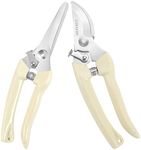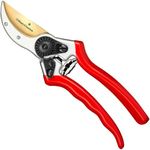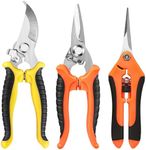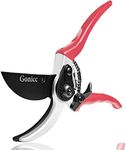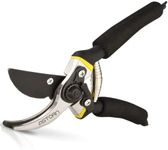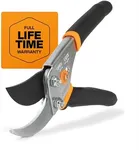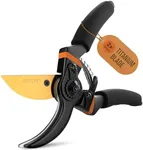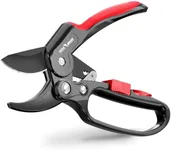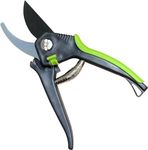Buying Guide for the Best Rose Pruning Shears
Choosing the right rose-pruning shears is essential for maintaining the health and appearance of your rose plants. The right pair of shears will make your pruning tasks easier and more efficient, ensuring clean cuts that promote healthy growth. When selecting rose-pruning shears, consider the following key specifications to find the best fit for your needs.Blade MaterialThe blade material of pruning shears is crucial because it affects the sharpness, durability, and ease of maintenance. Common materials include stainless steel, carbon steel, and titanium-coated blades. Stainless steel blades are resistant to rust and easy to clean, making them a good choice for general use. Carbon steel blades are extremely sharp and durable but require more maintenance to prevent rust. Titanium-coated blades offer extra durability and resistance to corrosion. Choose a blade material based on your maintenance preferences and the frequency of use.
Blade TypeThere are two main types of blades for pruning shears: bypass and anvil. Bypass blades work like scissors, with two curved blades that pass by each other to make a clean cut. They are ideal for live, green wood and delicate stems, as they minimize damage to the plant. Anvil blades have a single straight blade that cuts against a flat surface, making them suitable for cutting dead or hard wood. If you primarily prune live rose stems, bypass shears are the better choice. For tougher, dead branches, anvil shears may be more effective.
Handle DesignThe handle design of pruning shears affects comfort and ease of use. Look for ergonomic handles that fit comfortably in your hand and reduce strain during prolonged use. Some handles have non-slip grips or cushioning to enhance comfort. Additionally, consider the size of the handles; smaller handles are better for those with smaller hands, while larger handles may be more comfortable for those with bigger hands. Choose a handle design that feels comfortable and secure in your hand to make pruning tasks more enjoyable.
Cutting CapacityCutting capacity refers to the maximum diameter of branches that the shears can cut. This is important because it determines the types of branches you can prune. Cutting capacities typically range from 1/2 inch to 1 inch or more. For rose bushes, a cutting capacity of around 3/4 inch is usually sufficient. If you have thicker branches to prune, look for shears with a higher cutting capacity. Match the cutting capacity to the size of the branches you expect to encounter in your garden.
Locking MechanismA locking mechanism is a safety feature that keeps the blades closed when not in use, preventing accidental cuts and protecting the blades. There are various types of locking mechanisms, such as sliding locks, squeeze locks, and twist locks. Ensure the locking mechanism is easy to operate with one hand and stays securely in place. A reliable locking mechanism is essential for safe storage and handling of your pruning shears.
WeightThe weight of pruning shears can impact how comfortable they are to use, especially during extended pruning sessions. Lighter shears are easier to handle and reduce hand fatigue, making them ideal for frequent use. However, heavier shears may offer more cutting power and durability. Consider how long you typically spend pruning and choose a weight that feels comfortable for you. If you have limited hand strength or plan to prune for long periods, opt for lighter shears.

